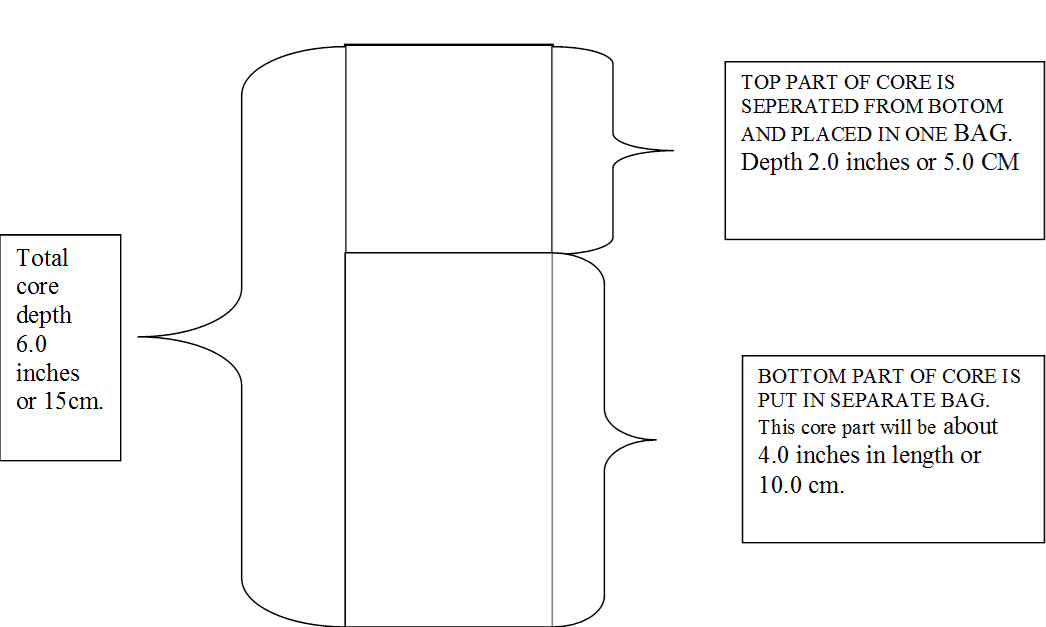|
|
|
|

Success Through Science
|
|
|
|
|
|
|
|
| SOIL SAMPLING PROCEDURE FOR REPORT INTERPRETATION AND PREDICTION |

Laboratory information is necessary to identify present problems and conditions, and to enable accurate predictions of future problems that will most likely occur under certain conditions.
This information is necessary to both fix and prevent problems. Just remember “PRESCRIPTION WITHOUT DIAGNOSIS IS MALPRACTICE.”
The following methods of taking samples will make the information received from the laboratory analysis much more meaningful.
- SAMPLE DEPTHS: In many cases, (golf courses and athletic playing fields), the soil at the surface will be very different to the soil found down in the profile. These differences enable you to interpret and to project both long term and short term problems.
Since we need to know the differences in soils at each of the depths, it is recommended that samples be pulled in the following manner.
A. The (2) depths should be pulled as one sample core and separated into bags that clearly designate depth and location. (MORE LATER ON THIS).

-
AMOUNTS REQUIRED Per SAMPLE: There are depth lines on each sample bag that should be observed, but in any case a sample of <0.75 lbs. or 350 grams will not be enough.
-
HOW MANY CORES SHOULD YOU PULL: It is not necessary to pull more cores than the number required to meet the sample requirements indicated in No. 2 above.
-
FROM WHERE SHOULD YOU PULL CORES: If grass is present on golf greens, soccer fields, etc., it is best if you are able to compare the good or better areas to bad turf areas, therefore you should be able to get an extremely good overview of most areas with (4) samples as follows.
A. One top 2.0 inch (5.0 cm) sample from a good area.
B. One bottom 4.0 inch (10.0 cm) sample from the same good area.
C. One top 2.0 inch sample from the bad area
D. One bottom 4.0 inch sample from the bad area.
NOTE: The above (4) samples might represent two different golf greens or a single soccer field.
-
PREPARATION OF SAMPLES & RECORDS: There is certain required paperwork for your samples and if this requirement is not met the laboratory will not run the analysis and the off site agronomist cannot interpret them.
A. Each sample bag must clearly identify where the sample came from.
NOTE: In our case the depth form which the sample was pulled is extremely important as well. The following coding designations should be followed.
GOOD AREA – Top 2.0 inches = GT-2
GOOD AREA – Bottom 4.0 inches = GB-4
BAD AREA – Top 2.0 inches = BT-2
BAD AREA – Bottom 4.0 inches = BB-4
B. The above should be clearly written on the sample bags and then the same information must be transferred to the laboratory information sheets that you will be furnished.
NOTE: Once the information is transferred to the laboratory information sheet, pack one copy in the box with the samples you will be shipping and retain one copy for your records for future reference.
-
SHIPPING THE SAMPLES: If shipping from outside the US you will be supplied with USDA import permits. A clear copy must be taped on the outside of the shipping box where it is visible in its entirety. If you forget this the sample will not clear customs and will not be processed.
SELECTING YOUR SHIPPER: First rule: Not all import shippers are equal!!!! If you do not understand this your samples may never get through U.S. Customs. While there are choices other than FEDEX, we recommend DHL.
-
WATER SAMPLES: Water content and quality is always an important consideration as it dictates a lot of the chemical aspects of the soil.
Therefore, it is always both advisable and desirable to have a water analysis done.
A. The water sample: Should be a minimum of 0.5 liter in a sealed leak proof container that is clearly marked.
B. The water sample can be shipped in the same box with the soil sample, and should have its own laboratory information sheet that is wrapped around the sample bottle and secured with a rubber band.
|
|
|
|
|
|
|